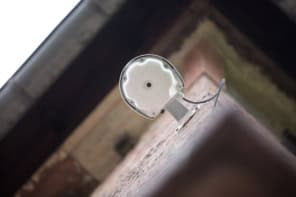A PhD in physics is the perfect basis for a career as an engineer, as Ken Cooper from NASA’s Jet Propulsion Laboratory tells Susan Curtis
You don’t have to be a rocket scientist to work at NASA’s Jet Propulsion Laboratory (JPL) in Pasadena, California, though it probably doesn’t hurt. That’s what condensed-matter physicist turned radar engineer Ken Cooper discovered when he joined the federal laboratory in 2006. Although it is best known for the development of a slew of different spacecraft – Explorer 1, the first US satellite, was launched by JPL in 1958 – this national research facility has a vast array of missions and projects today. It covers everything from robotics to interplanetary spacecraft, from earth sciences to planetary monitoring systems and technologies.
Cooper has spent the last dozen years as a radio-frequency (RF) microwave engineer at JPL. During that time he has moved from developing terahertz imaging radars and transceiver arrays for national security applications, to building submillimetre-wave molecular spectroscopy and radar techniques for atmospheric studies. But what made Cooper, a physicist by training, switch to an engineering-focused role in industry? I spoke to Cooper to find out what drove his self-described “non-ballistic career trajectory”, and to find out how his PhD in physics gave him the necessary tools and skills for a career as an engineer.
What sparked your initial interest in physics and what influenced you to pursue the subject at PhD level?
As a kid, I was always interested in science and physics. By middle school I started reading some popular books such as Stephen Hawking’s A Brief History of Time. In college, although I was considering medical school, I liked physics best. I decided that I would try and stick with the subject as long as I was successful. I got good grades and I felt like I wanted to study physics at a deeper level. I interviewed for one job towards the end of college, through a recruiter, but mainly I was focused on getting into graduate school. I did my PhD in condensed-matter physics at the California Institute of Technology, followed by a postdoc in superconducting quantum computing at the National Institute of Standards and Technology and the University of California, Santa Barbara. Ultimately, I found my way to JPL, which I’ve found to be very fulfilling, so I don’t regret leaving academia.
How did you make the move from research into the more industrial aspects of terahertz technology?
After my postdoc, I found a number of groups at JPL doing activities that I would have fitted very naturally into. Unfortunately, they didn’t have any open positions at the time. Now that I’m here, I can see how such a situation arises – you very rarely have enough extra funds to hire people. You get research grants to do very specific tasks with personnel that you already have on the staff. In general, JPL or NASA is not a growing institution, and it’s very hard to break in.
But I really wanted to work at JPL, so I reached out to a number of contacts. I was lucky that the head of the terahertz technology group, who also had a background in physics, saw something in me, and fortunately made me a job offer in 2006. I thought I would be doing things more in line with my expertise, but because of what projects were available then, and how I hit the ground running, I just ended up running in a different direction. Despite working as an engineer, I haven’t diverged that far from physics – indeed, I work with other physicists who are now doing engineering.
What were some of the challenges you experienced when you first began working as an engineer at JPL?
There were a lot of challenges. I could list 20 of them easily. Some that come to mind are learning the new skills and concepts of terahertz technology. When I got here, if I wanted to know what 1 dB or 5 dB was, I would have to calculate it in my head or on a calculator. Now I’ve memorized it, because I use them so much. There is a gap of some knowledge to get into radio-frequency engineering from another field.
Working in an engineering environment was a challenge, especially once I had to work on proposal writing and project management. There are very structured ways that you have to plan out a project in engineering: you have milestones, and you have a schedule, and you have a team. You must describe to your sponsor exactly what you’re going to do and when you’re going to do it, even if you know it’s very unlikely to go that way. In the well-funded physics teams I had been in, a student or postdoc almost never had to worry or think about that. You just got to explore new physics. You weren’t thinking about trying to hit this milestone by that date – you had a general sense of where you were going. At a NASA lab, it’s much more organized and engineering-oriented, and I had to adapt to that way of working and thinking.
Were there other differences you noticed when it comes to a physics rather than an engineering approach to solving a problem?
At JPL I work with researchers across a wide spectrum of scientific fields. While there are plenty of people with backgrounds similar to mine, there are also many who come from different technical areas with their own knowledge and experience. To me, this is one of the main benefits of working here. A close colleague of mine, for example, is an expert when it comes to radio and electronics. I come from a device-physics background, so we made a good team. It has been great to find people whose skills are complementary to my own, and develop relationships with them. There are also colleagues I think of as theoretical engineers. These are very bright individuals doing complex analytic tasks, way beyond my head as an experimentalist. It was rewarding to get to know them and learn how they approach problems.
What projects are you working on now?
My two main projects involve millimetre-wave radar and submillimetre-wave spectroscopy. As far as the radar projects go, I’ve transitioned from security applications to NASA-oriented science applications. One is a 95 GHz Doppler radar to measure plumes that come out of comets or icy moons in the solar system. This is a technology-development project and not an actual instrument that will fly. We’re maturing the technology so that it could potentially go on a future mission. It’s what we would call “lower technology readiness level” and it’s more academic from that point of view.
The second project involves earth science. We use a radar that is tuned near 180 GHz, where there’s a strong water-absorption feature in the atmosphere. We’re building it to be able to resolve profiles of humidity inside clouds. This is very important for climate models, for weather predictions and for understanding cloud formation. We hope to deploy this radar on an aircraft and do actual measurements in the field, so it’s a very exciting project. As far as the physics perspective is concerned, I’m still on the experimental side of things, developing new measurement techniques, collecting data, building hardware.
As an engineer now, do you still find that your physics background helps?
I think it does. Although you could do my job if you trained as an electrical engineer from the start, I do see some differences, especially when I get caught up a little bit more than other colleagues in wanting to know the details behind certain studies. For example, where someone else might be satisfied with looking up what the cross-section is of water molecules at 557 GHz, I found a paper describing how to calculate this using Einstein coefficients. Thanks to my physics background, I could delve into that a bit more than some engineers I work with. That’s not necessarily better, and it’s not necessarily more useful to do that, but it’s more rewarding for me.
When it comes to physics and engineering, there’s a degree of mutual admiration. As a physicist, I feel like I don’t have training or expertise in certain software packages especially, or expertise in very complex RF design. On the other hand, device engineers I work with might look at my background and wish they had the deep training I did in semiconductor physics, Fermi levels, gallium arsenide and all sorts of such details. I don’t think either perspective is true – in the end, we work together and use all our skill sets.
Have you got any advice for today’s physics graduates, who are starting out in their careers?
I think it’s very good training to get a PhD in physics. When you tackle difficult problems, you learn what it means to be an expert in something, and you also learn humility. You should also have a passion for science and a love for learning – then, scientific research, whether in academia or industry, can be a very rewarding career to pursue. A PhD in physics gives you skills that are transferable to a number of industries. If you decide you want to make a change when you’re in your 20s or 30s, I think you can do that, and find ways to succeed in many different fields.




